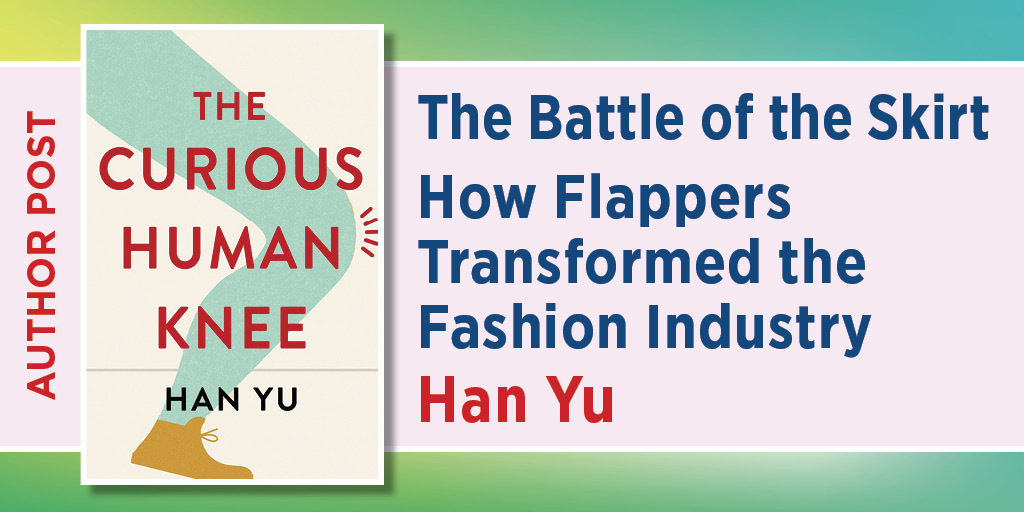The Battle of the Skirt
How Flappers Transformed the Fashion Industry
Han Yu

I can show my shoulders,
I can show my knees;
I’m a free-born American
And can show what I please.
***
On August 23, 1923, the Parent Teachers Association of Somerset, Pennsylvania, gathered for a solemn task: petition the school board to adopt old-fashioned school uniforms and bar “short skirts, bobbed hair, and low-necked, sleeveless dresses.”[i] Catching wind of this, the town’s flappers came uninvited, delivered the snappy rhyme, and stormed out, leaving the parents and teachers seething with indignance.
The Associated Press picked up the story, spreading it to newspapers across the country. In Wilmington, Delaware, the Morning News announced that flappers had risen to defend their “near nudity.”[ii] In 1920s America, women didn’t have to do much to be accused of practicing nudity.
On some level, I guess, the accusation makes sense. Only thirty years earlier, skirts had been floor length, barely showcasing women’s shoes.[iii] Indeed, from ancient Greece and Rome onward, the concept of “short skirts” was largely unknown to Western civilizations.[iv] Skirts, dresses, and gowns were meant to cover up the legs, to pretend that women don’t have ankles, much less knees.
Given this fashion history, the flapper’s attire was nothing short of scandalous to her contemporaries.
Given this fashion history, the flapper’s attire was nothing short of scandalous to her contemporaries. Head to toe, multiple qualifications made the flapper, three of which specifically concerned her knees: a knee-length fringed skirt, exposed bare knees, and rolled hose to accentuate said knees.
To further ensure that their knees stood out and were put forward in the best light, flappers took to another fashion practice: rouge them. “The idea is to get just the faintest pink effect—a coat of rice powder, the slightest touch of rouge on the knee cap and a film powder over that.” [v] The effect was promised to be quite charming. The more creative and ambitious also painted their knees. This, according to beauty specialists, was “the latest thing.”[vi] One might choose from a variety of designs, simple and elaborate: “Some girls prefer a flower or a group of blossoms. Others like a portrait or a little landscape.”[vii]
With their fashion outrage, flappers were often held up as extraordinary rebels: brave and liberated, they smoked cigarettes, drank alcohol, and danced the Charleston, single-handedly bringing about women’s dress reform. This picture is, alas, more Hollywood (and Fitzgerald) than history. In reality, seventy years of fashion rebels had preceded—and one might say enabled—the flappers and their exposed knees.
Two disparate groups raised the issue of dress reform: water curists and women’s rights activists.
Although skirts had always been devised to hide the female lower body, the Industrial Revolution and its attendant technology took this to the extreme. Power-driven looms churned out great quantities of fabric, which allowed skirts to swell with layers of petticoats.[viii] The sewing machine then added complicated stitching and intricate trimming, tons of it.[ix] If lavish petticoats and decorations made for an attractive dress, they also made for a heavy one. Weighing in the neighborhood of forty pounds,[x] such outfits effectively forced women into a sedentary lifestyle, moving as little as possible and carrying nothing of substance. On hot summer days, layers of fabric became a heat trapper, creating additional discomfort that deterred movement.[xi]
At this juncture, some women finally said enough was enough. Two disparate groups raised the issue of dress reform: water curists and women’s rights activists.
Water cure is a form of alternative medicine that became massively popular in the United States around the mid-nineteenth century. Water cure facilities championed baths, foot washing, and compresses, together with diet and exercise, to promote healing and health.[xii] An inherent part of the regimen was healthy, rational clothes for women, with the signature piece being the bloomer dress: a knee-length skirt accompanied by some sort of pants underneath. Such a dress, the water curists believed, would allow American women to be free and healthy—so they could, in turn, give birth to and raise wise and great men. … Yeah, the water curists, passionate though they were about women’s health, had no grand vision for their roles outside the home and beyond child-rearing.
Yeah, the water curists, passionate though they were about women’s health, had no grand vision for their roles outside the home and beyond child-rearing.
It was through women’s rights activists that the bloomer dress took on a more progressive tone. These activists, the so-called bloomerites, donned the short dress and stood on the podium to demand women’s civil and political rights: the ability to vote, to own property, to receive education, to work. Sadly, on the podium the dress didn’t last long. The general public, unlike fellow invalids at secluded water cure resorts, had no sympathy for bloomerites. Rather than heeding the activists’ words, the public was engrossed with their dress and, hating that, found their words even less tolerable. Fearing that their costume was hurting rather than helping their political cause—and tired of the constant harassment—one by one, the activists lengthened their skirts.
If a long line of smart and brave women had failed to bring widespread adoption of short skirts, what allowed the young flappers to succeed in exposing their knees?
The change didn’t happen overnight. The hemline had started to rise in the 1910s, was well above the ankle and showing calves in 1920, hovered around the knee by 1925, and then threatened to expose the knee in 1927. Behind this gradual change were the rising public awareness of women’s dress reform, as well as several other factors.
The bloomer costume was thus an abomination, a usurper of male superiority and power.
The first is World War I. The war considerably damaged France’s cotton and woolen mills, and French designers, trying to conserve fabric, adopted a straight silhouette and raised the hemline.[xiii] Paris being the world’s fashion capital then as now, women’s clothes on both sides of the Atlantic followed suit. The blessing of French designers and the fashion industry at large led to one crucial difference between the failed bloomer costume and the popular flapper outfit: aesthetic perception. Although nineteenth-century American women conceded that the bloomer costume was suitable for walking, hiking, and cycling, they nonetheless thought that it was “ugly,” “very ugly,” “supremely ugly.”[xiv] The flapper dress, by contrast, was advertised as youthful and charming through Sears catalogs, magazines like Good Housekeeping, and movie stars like Clara Bow.
Aside from being pretty, the flapper outfit differed from the bloomer costume on another crucial front: the flapper outfit was, through and through, a dress; the bloomer costume was dangerously ambiguous by utilizing trousers. Although the trousers were baggy and hid women’s legs well, they were still considered indecent—because by nineteenth-century standards, trousers, or anything else bifurcated, belonged to men. The bloomer costume was thus an abomination, a usurper of male superiority and power.
By the late 1920s, the fashion industry, alarmed that the flapper design had remained stable for several seasons, tried to bring back long skirts and a fitted silhouette, which would create a different look, sell more fabric, and also boost the sales of corsets and girdles.[xv] But women refused to buy into the new design. Some did so for aesthetic reasons; others saw the long skirt as a return of sartorial shackles and an attempt to take away their votes.[xvi] This battle of the skirt ended with a partial victory on both sides: while evening and formal wear lengthened, daywear remained short.
Han Yu is a professor in the Department of English at Kansas State University and the author of The Curious Human Knee.






